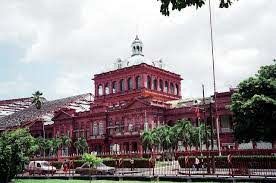Summary


Emancipation Day
Emancipation – The fact or process of being set free from legal, social, or political restrictions; liberation. The freeing of someone from slavery.
Definition
Emancipation Day celebrates the freeing of the African slaves.
For more than three centuries, between 1518 and 1834, millions of people from their homes in Africa were forcibly transported across the Atlantic Ocean to the New World. They were enslaved, forced to work in the sugar plantations. In Trinidad and Tobago, their enslavement continued until 1 August, 1834 when the Emancipation Bill was passed and came into effect freeing thousands of slaves in the British West Indies.(source)
On 1 August, 1985 the government of Trinidad and Tobago declared Emancipation Day a national holiday to commemorate the abolition of slavery. The day replaced the celebration of Discovery Day.
Emancipation Day celebrations take the form of :
- Lectures,
- street processions,
- religious services, and
- cultural shows.
Emancipation means that nationals reflect on their freedom, the effects or plight of slavery.
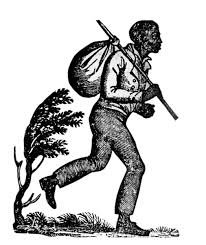
Indian Arrival Day
Indenture refers to a legal and binding agreement, contract, or document between two or more parties. Historically, indenture has also referred to a contract binding one person to work for another for a set period of time
Source
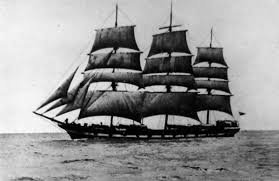
Indian Arrival Day, a public holiday, is celebrated on 30th May every year. It commemorates the arrival of the first Indian Indentured labourers from India to Trinidad, in May 1845, on the ship Fatel Razack. The last ship was the Ganges which docked on April 1917. Indian Immigration to Trinidad spanned the period 1845-1917. During this period over 140,000 Indians were transported to the island.
The East Indians came as a new labour force to assist in the economic development of Trinidad. They came to work on the sugar cane plantation as indentured labourers. They were given a salary, free lodging on the estates, free medical attention, and a piece of land to grow their food. They were also given a return passage to India after their 5-year indentureship.
The East Indians bought with them their tradition, cultures and religions. Today, aspects of the East Indian culture is dominant in Trinidad and Tobago.
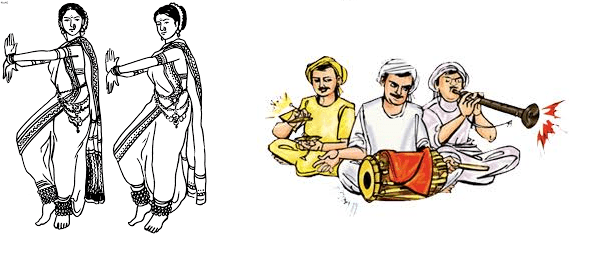
The History of Indian Arrival Day
Independence Day
Independence – the state or quality of being independent. Freedom from the control, influence, support, aid, or the like, of others.
Definition
Trinidad and Tobago was granted Independence on August 31st, 1962.
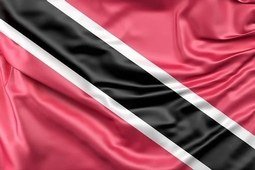
The flag was raised for the first time at midnight on 30th August, 1962. Bells tolled and sirens rang out to herald the birth of the newly independent nation. In the week (August 28 to September 5), there were much festivities across the country. It was an auspicious occasion. The Queen had sent a Royal representative to read her message relinquishing her rule.
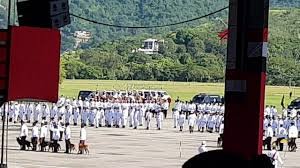
Today, Independence Day is celebrated with military-style parades at the Queen’s park Savannah in Port of Spain and in Scarborough (Tobago). The President and the Chief Secretary (who is the leader of the Tobago House of Assembly) secured the role of inspecting the the respective parades.
There is live music played by bands of the various forces (e.g. Police, Fire, etc.). Later, at the President’s House, awards will be handed out to citizens of Trinidad and Tobago who were outstanding in their various fields. Finally the celebration comes to a close with a brilliant firework display at the Queens Park Savannah and at Scarborough.
The first event of its kind heralded the beginning of a nation’s progression towards self-governance. The others celebrate our accomplishments as a nation under self-governance.
Changes that took place
- Trinidad and Tobago had its own: national anthem, national flag, coat of arms, national motto, national awards.
- Trinidad and Tobago had its own Army and Coast Guard.
- The title of Premier was changed to Prime Minister.
- Trinidad and Tobago now control their own finances and decide the laws of the land.
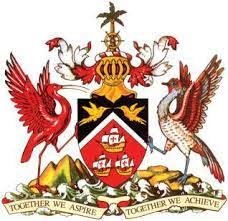
The National Anthem and the National Pledge of Trinidad and Tobago
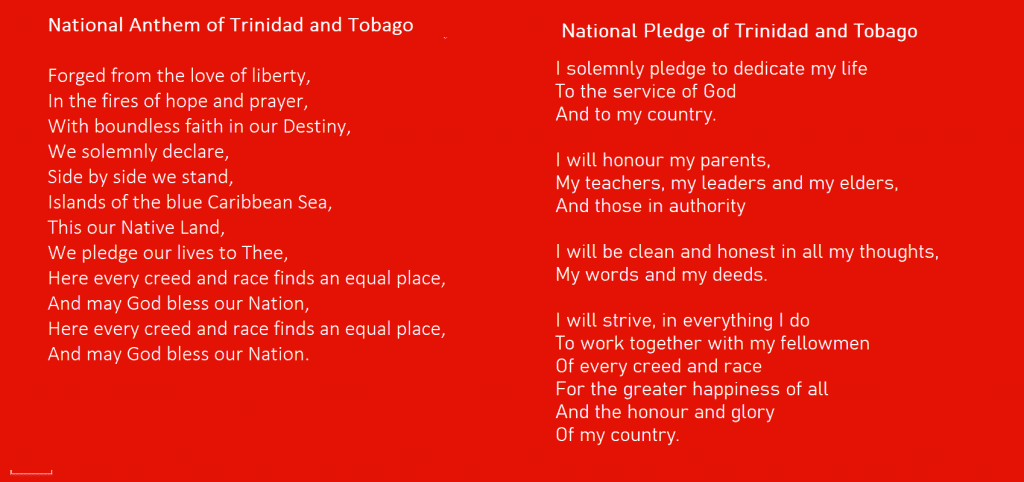
Patrick Castagne wrote the lyrics and melody for the National Anthem. Majorie Padmore wrote the words for the national pledge.

Patrick Stanislaus Castagne
(1916-2000)
Patrick Castagne was a Guyanese-born Trinidadian composer. He composed both the “Forge from the Love of Liberty” and the national anthem of Trinidad and Tobago.
Picture: Courtesy Trinidad Guardian.tripod.com
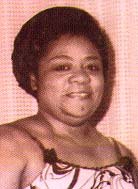
Majorie Padmore
Majorie Padmore composed for school children. She composed Trinidad and Tobago’s national song “God bless our nation” and “Our lands of Sun and Seas”.
Picture: Courtesy tntisland.com
The National Anthem
The Pledge was composed for school children and is usually recited at the opening and closing of school terms and on special occasions.
Another song you may also sing in school: God Bless Our Nation by Marjorie Padmore

Trinidad and Tobago Independence Day 2018
Trinidad and Tobago Independence 1962
Independence day address by Dr. Eric William, the first Prime Minister
Trinidad and Tobago Independence Day Ceremony 1962
Labour Day
Labour Day is a public holiday or day of festivities held in honour of working people. Labour Day celebrations in Trinidad and Tobago was declared an annual national holiday in 1973, and celebrated on June 19th (the anniversary of the day of the Butler Oilfield Riots which took place in June 19th, 1937).
This is the day protesters demanded better working conditions in the oilfields. These workers did not believe they were being treated well. Their hours of work was long and pay was meager for the the hard work. They often got sick and lost their jobs. They were demanding things change. The protest took place in the Fyzabad community. The workers marched the streets and police attempted to arrest some of them. Uriah Buzz Butler was one of them arrested and this had upset the protestors even more. Many people lost their life during this protest.
Today, Labour day is the time to remember the struggle workers of our nation experience to get better working conditions, low wages or salary, racism, abuse, and economic hardship.
Some important people to remember are:
- Tubal Uriah “Buzz” Butler
- Arthur Andrew Cipriani
- George Weekes
- Albert Maria Gomes
- Adrian Cola Rienzi
- Elma Francois
- C.L.R. James
Of these, the one most named is Tubal Uriah Buzz Butler. He with others were able to organize the first Trade Union in the country.
Adrian Cola Rienzi, A Short History
Today, we know also that all workers in Trinidad and Tobago have rights. When workers are paid better wages they can better provide for their families with food, clothing and shelter. They deserve time for a vacation or time to tend to their illness. Women are paid maternity leave when they are having babies. The sacrifices of Tubal Uriah “Buzz” Butler and others have help make Trinidad and Tobago a better more caring place for its citizens.
Republic Day
Republic – A state in which supreme power is held by the people and their elected representatives, and which has an elected or nominated president rather than a monarch.
Definition
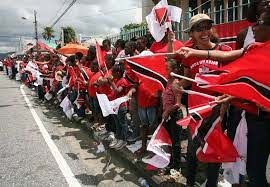
On August 1st, 1976, 14 years after Independence, Trinidad and Tobago became a Republic. Thus this act finally sever all ties with Britain. This event is celebrated as a public holiday on September 24th.
When Trinidad and Tobago became a Republic, this meant that the country no longer was required to owe allegiance to the Queen of Britain. The country can have its own Head of State.
Thus, the office of Governor General was replaced by the President of the Republic. The constitution (from its character as an Order in Council of the Queen) was changed to a new Republic Constitution. The President replaced the Queen as Head of State. the country also had its own currency.
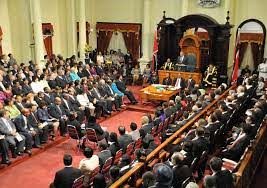
The House of Representatives sits at the Red House. It comprises of 41 members, elected to represent single-seat constituencies. Parliament is elected with a five-year term, or may be dissolved earlier by the President if so advised by the Prime Minister.
The Speaker of the House can be either one of the elected 41 members or come from outside.
